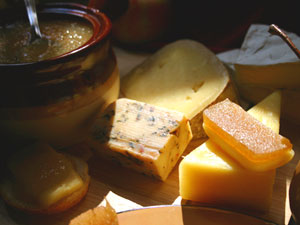30 Sep A Sensual Flamenco Alegria
 by Mark C. Tafoya
by Mark C. Tafoya
In considering this month’s Main Ingredient, pears, and the Indulgence, cheese, I couldn’t help but think of the interplay between these two. The sweet, crisp, clean flavor of pear and the creamy richness of cheese go well together, whether they are presented in simple slices as a picnic snack or in something more elegant, such as a pear and gorgonzola tartlet with hazelnuts.
However, my playful nature led me to have some fun with these two. I couldn’t help but think to reverse the roles for cheese and pears, and make the pears the indulgence with cheese serving as a base for the dulcimer subtlety of the pear. My mind started to wander to past experiences enjoying sweet fruits and cheeses, and, as always, this led me on a journey through world cuisines, with enticing connections along the way.
My first thought was of the Spanish tradition of pairing sheep’s milk cheeses with fruit preserves. This tradition finds its most common and beloved expression in the pairing of Manchego and carne de membrillo, a jellied quince preserve. The soft, nearly creamy texture and sweetness of the quince mellows out the sharpness of a nicely aged Manchego, properly dry yet not hard or crumbly. In Córdoba, where the moors left an indelible imprint on the culinary landscape, the nuns are famous for their quince pudding. This sweet citrusy fruit jellies very well, as it is high in pectin, the enzyme responsible for coagulation of fruit preserves.
The process is very simple. Joaquín Lacalle, in his book Andulusian Cookery, includes a very straightforward description of the method for carne de membrillo.
“Boil a few good yellow quinces and when they are tender, drain, peel and put in an electric blender. Add equal quantities of the quince and sugar and boil for 25 minutes, stirring with a spatula so that it does not stick. When this thickens, cool in moulds (preferably made of glass). In some areas this is flavored with cinnamon” (233).
 Although famous for Flamenco, Andalusia is not the only region with a tradition of fruit and milk preserves dancing together in a tempting and sensual duet. All over Spain and Portugal , farmers and home cooks have made fruit cheeses or marmalades to continue to enjoy the ecstasy of fruit and cheese throughout the long winter. In the Apulia region of Italy , one finds cotognata, and in France cotignac d’Orleans, both made with quince.
Although famous for Flamenco, Andalusia is not the only region with a tradition of fruit and milk preserves dancing together in a tempting and sensual duet. All over Spain and Portugal , farmers and home cooks have made fruit cheeses or marmalades to continue to enjoy the ecstasy of fruit and cheese throughout the long winter. In the Apulia region of Italy , one finds cotognata, and in France cotignac d’Orleans, both made with quince.
In Portugal and its former colonies, there is a tradition of preserving pears as perada, along with a host of other fruit cheeses. C. Anne Wilson, in her definitive The Book of Marmalade, explains that the English word marmalade originally came from the Portuguese marmelo, which was their version of membrillo; the British brought these fruit preserves back with them along with their stash of porto and sherry. While now we know marmalade to be a preserve of bitter oranges, it has its origin in quince jelly. Wilson notes that quince was then and is still added to many fruit preserves because of its high pectin content, as well as the brightness it imparts in the final product.
Even in far-flung Goa, in Western India, 450 years of Portuguese rule influenced the culinary traditions there. In a land where Hindu and Christian, Indian and Portuguese traditions mingled, the locals make a perada using guava, which is more available locally than pears.
Across the sea in the Caribbean, many Latin American cultures likewise make dulce de guayaba. This may have come by way of the Conversos, Sephardic Jews who fled the Inquisition in Spain , secretly continuing to practice their Judaism in the New World . In Brasil and other South American countries, the term “Romeo and Juliet” refers to the star-crossed pairing of queso blanco, or any soft young white cheese, with membrillo, guava paste, or perada. In Argentina , chefs make membrillos with vanilla, sweet potato, chocolate, cranberries and pumpkin. Thankfully, none of these pairings end with an apothecary’s vial or a dagger.
 So this, then, is my recommendation for a romantic Alegria of cheese and pears which will finish sensually, like a Flamenco dance, with no sour notes.
So this, then, is my recommendation for a romantic Alegria of cheese and pears which will finish sensually, like a Flamenco dance, with no sour notes.
Recipe: Perada
Create a cheese platter with the best cheeses you can afford. If you can find an aged Manchego from Spain , include a wedge of it, along with a soft white cheese, such as a young Camembert. I paired the perada with a one-year-old pecorino from Valley Shepherd Creamery in Long Valley, NJ , an artisanal house that focuses on sheep’s milk cheeses. You can even be more adventurous and include a sharp cheddar infused with other flavors. I included an organic Tomato Basil Fromage du Mont from Eklund Farms in Stamford, NY. If quinces are available to you, make a membrillo as well, and pair it with the stronger of your cheeses. If not, then prepared membrillo is pretty widely available in specialty shops or online.
Photos: Mark Tafoya
Mark Tafoya is the executive chef and culinary editor of the Gilded Fork, and the founder of the Culinary Podcast Network. He is also the chef/owner of ReMARKable Palate Personal Chef Service in New York City.

